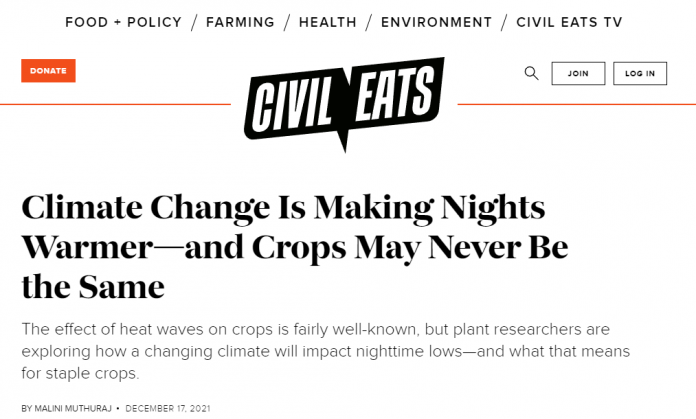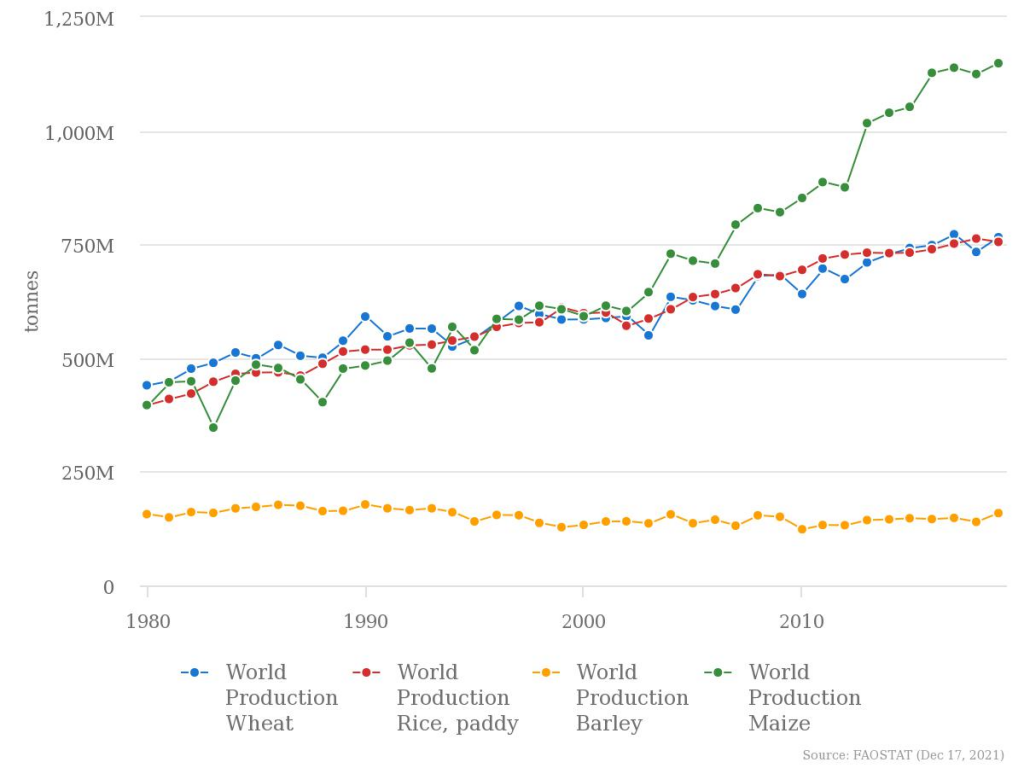Near the top of the list of stories produced during a Google news search for the phrase “climate change” today is report in the daily agricultural news site Civil Eats claiming modestly higher nighttime temperatures driven by climate change threatens staple food crops. This is false. In fact, data shows, just the opposite is the truth, modest warming and higher carbon dioxide levels is boosting, rather than suppressing crop production.
“Climate Change Is Making Nights Warmer—and Crops May Never Be the Same,” is the title of a Civil Eats story, the premise of which is higher nighttime temperatures threatens staple cereal crop production.
“The world is getting hotter than ever before, with temperatures across the globe reaching new extremes in recent decades,” write Civil Eats. “[O]vernight temperatures are also breaking records, sparking concern about human health and ecosystem impacts.
“It isn’t just people who are impacted by these climate anomalies; plant species are also under threat, including major food crops such as rice, wheat, barley, and corn,” Civil Eats asserts.
Data from the United Nations Food and Agriculture Organization (FAO) shows this assertion is false. As shown in the graph below, the staple crops Civil Eats warned are threatened by slightly warmer nights have repeatedly set records for yield and production during the recent period of modest warming globally.
Data from the FAO show since 1980:
- Global rice production increased by more than 90 percent.
- Global wheat production grew by approximately 74 percent.
- Global barley production increased by about 1.5 percent.
- Global corn production increased by approximately 190 percent.
Although some of this increase is certainly due to the increasing adoption of modern agricultural techniques and technologies in developing countries during the past 40 years, research shows the most important reason for the increase is the fertilization effect of increased atmospheric carbon dioxide levels, and improved climate conditions for growing crops.
Indeed, Data presented in The Heartland Institute report, “The Social Benefits of Fossil Fuels,” demonstrate the “increase in atmospheric [carbon dioxide] concentration … caused by the historical burning of fossil fuels has likely increased agricultural production per unit [of] land area by 70 percent for C3 cereals [which include rice, wheat, oats, cotton, and evergreen trees], 28 percent for C4 cereals [which include sorghum, maize, and various grasses], 33 percent for fruits and melons, 62 percent for legumes, 67 percent for root and tuber crops, and 51 percent for vegetables.”
Agronomy explains why crops production is booming under current climate conditions. As detailed by the Non-governmental International Panel on Climate Change in Climate Change Reconsidered: Biological Impacts and Climate Change Reconsidered II: Fossil Fuels, the carbon dioxide humans have been pumping into the air since the middle of the 20th century has enriched plant growth, thereby contributing to record crop yields, helping to bring about the largest decline in hunger, malnutrition, and starvation in human history.
Not only do plants thrive under conditions of higher carbon dioxide, they also use water more efficiently, losing less water to transpiration. And it’s not just crops, study after study shows higher carbon dioxide levels is contributing to a general greening of the earth.
The addition of approximately 135 ppm of carbon dioxide to the atmosphere by humans—through the burning of fossil fuels, slash-and-burn agriculture, and various other actions—has helped reduce hunger immeasurably.
Despite the addition of 3.2 billion people to the planet since 1968, the United Nations reports hunger has fallen at a faster rate than at any time in human history. Although 700 million people worldwide still suffer from persistent hunger, according to the U.N., the number of hungry people has declined by two billion since 1990. Additionally, research shows there is now 17 percent more food available per person than there was 30 years ago—all during the period of purportedly dangerous climate change due to human carbon dioxide emissions.
Weather has always been a source of concern for farmers. Crop prices, prices for inputs, financial concerns, international trade disputes, and persistent and emergent pests are among other sources of heartburn for farmers each year. If Civil Eats truly wants to inform and help its readers, its time would be better spent reporting on these factors which have always plagued agriculture, and the potential solutions to them, rather than jumping on the climate change alarm bandwagon.
Farmers have many reasons to worry about crop production, but climate change is not among them.
















